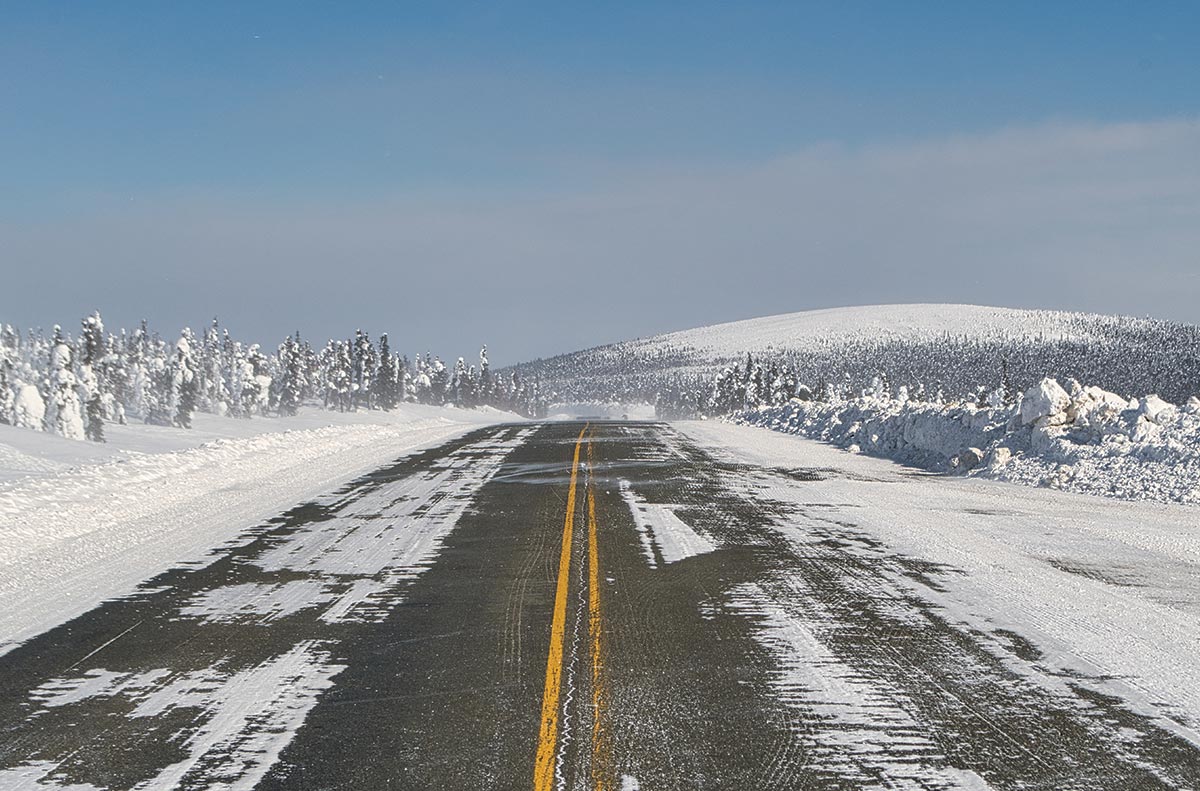Oil & Gas
Carter Damaska | Alaska Business
Local Suppliers Have the Right Supplies
n Alaska there are wider temperature variations than almost anywhere in the United States: near Fairbanks, temperatures range from 80°F or 90°F in the summer to -70°F in the winter. As harsh as that is on people, those conditions are especially brutal on machines and materials.
Normal asphalt, for example, isn’t up to meeting those demands. That is where polymer-modified asphalt comes in. The polymer stiffens the asphalt and increases its resilience in high temperatures, resulting in reduced cracking and rutting. At low temperatures, polymer-modified asphalt resists thermal cracking.
Denali Materials, a wholly owned subsidiary of St. Mary’s Native Corporation, manufactures polymer-modified asphalt and asphalt emulsions used in road and runway construction. “We add rubber polymers and other constituents to the mix to meet higher-level specifications for highway or runway paving. This is to prevent rutting and cracking on the roads,” explains General Manager Scott Hayden. The asphalt binder is sold to a contractor that blends it at an elevated temperature to produce a homogeneous asphalt paving mixture, called a hot-mix asphalt.
Depending on the specific blend of materials, modified asphalt can withstand either hot or cold temperatures, though mitigating both is difficult.
The specialty surface is vital to maintaining the only haul road to the North Slope, the Dalton Highway. Less than one-third of the 414-mile road is paved; north of the Brooks Range it’s gravel on all but three stretches totaling 17 miles. There, the average temperatures during the summer months are typically barely above freezing, while those in winter are as low as -20°F or -30°F. Sometimes, temperatures can even dip to -50°F or -60°F.
Such extreme cold obviously affects more than roads and runways; it can reduce the efficiency of materials and equipment or even cause them to fail entirely. What many oil field operators and contractors have found is that ordering a different part from another far-off manufacturing plant may or may not solve the problem; however, relying on local experts to fabricate a solution often works out well.
Alaska Rubber Group is what CEO Mike Mortensen calls a value-added distributor and not simply a hardware store. “We supply hoses and fittings, rigging and lifting supplies, conveyor belts, sheet rubber, pumps, and various other equipment,” he says. None of those products are factory stock; they are assembled to the customer’s exact specification.
“Many of these products are rated to -65°F,” Mortensen says, “which you don’t see in Texas oil fields or other companies in the Lower 48. We have honed our understanding of cold weather products over a lot of years, especially for use in Prudhoe Bay.”
Alaska Rubber Group is more than a middleman between manufacturers and end users. The shop assembles and tests its products, such as hose fittings.
Carter Damaska | Alaska Business

Carter Damaska | Alaska Business
Suppliers are not merely wholesalers, passing out-of-state materials along to clients; they take an interest in delivering products in a ready-to-use form factor with special formulations for the North Slope.
“The supply community in Alaska is pretty advanced when you compare them with the Lower 48 cohorts,” Mortensen says. “We operate in some extreme conditions, and we’ve become specialists. This is true not only in the products and the stock of supplies in the market but the know-how. We have an understanding of this market and the Alaska oil fields. There is a lot of value there that the oil field contractors and operators can’t get elsewhere.”
From the perspective of an industry supplier, recent turnover in the operators of Alaska’s oil patch has been positive for the state. Mortensen points out that Hilcorp, after buying out BP’s assets, operates differently than the multinational giant did, working more nimbly with innovations that recover more oil from existing fields.
Nimble clients demand swifter suppliers, however. “There is a digital transformation happening all over the place,” Mortensen says. “Customers operate on a 24/7 basis, and they want access to products and information quickly. For the supply community in Alaska, we have to adapt to that. We have to offer the technology to our customers to engage with suppliers in the way that they expect. It’s not good enough to be open from nine to five, Monday through Friday.”
To satisfy those ever-present needs, Alaska Rubber Group has made it a practice to keep a cache of parts and supplies on hand. This was a benefit to the company and its customers during recent distribution delays and shortages.
The James W. Dalton Highway, built in 1969 but not completed until 1977, starts at the Elliott Highway north of Fairbanks and ends at Deadhorse, just short of the Arctic Ocean at Prudhoe Bay. The lifeline to the oil fields requires special asphalt to survive harsh conditions.
SRIMAN EMANY | iStock
SRIMAN EMANY | iStock

The asphalt for Denali Materials is already close at hand; it’s mainly made from North Slope crude oil. “What we do is we buy liquid asphalt from the refinery,” Hayden says. “That would either be from Marathon Refinery down in the Nikiski or the Petro Star Refinery in North Pole that also produces asphalt.”
Coming full circle, the oil industry supplies the raw material that its suppliers use to pave the Dalton Highway that keeps Prudhoe Bay humming.
The hum is lower than it used to be, with the oil industry workforce still reduced compared to its pre-pandemic level and North Slope output years past its peak—but new projects still just over the horizon.
“We’ve seen the swings in the business,” Mortensen says, “and if you are serving the oil and gas business, it’s a mixed bag. When business is good, it’s really good, and when it is bad, it is really bad. Fortunately, I feel we are on an upswing here in Alaska.”
To find out which oil projects Alaska’s Top 49ers are preparing for, choose this article.
To read more about Alaska Rubber Group, choose this article.